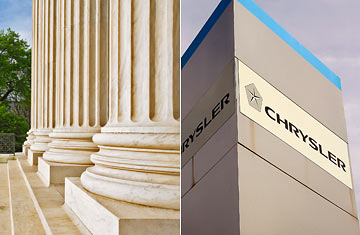
The prospect of liquidation had loomed large on Monday when the Supreme Court put the brakes on Chrysler's emergence from Chapter 11. But the visions of a messy unbundling of the venerable automotive giant melted away on Tuesday evening after the high court declined to extend the stay imposed by Justice Ruth Bader Ginsburg.
The Supreme Court had issued the stay to consider objections to the capital structure of the revived company that were made by Indiana's pension agency, a secured creditor that got bumped from the normal bankruptcy pecking order in the U.S. government-sponsored reorganization. The United Auto Workers, which is further down the priority list, ended up with 55% of the proposed Chrysler-Fiat combination, which is scheduled to close June 15. Chrysler's largest secured lenders will get $2 billion at the closing; they were owed $6.9 billion. (See the top 10 Chrysler moments.)
It is not unusual for employees to get priority in a bankruptcy. "Even in an ordinary case, employees are treated differently than general creditors," says David Skeel, professor of corporate law at the University of Pennsylvania and a bankruptcy expert. What's unusual here, he says, is how sweet the deal seems to be for the union. "The deal favors employees and particularly retirees — and they do look like an ordinary creditor. It looks extraordinarily generous." It's also odd that the U.S. government was effectively on both sides of the negotiating table, he adds.
But shoving aside some creditors is also par for the bankruptcy course. "It's not like this would be the first time that different classes got crammed down, effectively," says Kimberly Rodriguez, co-leader of global automotive services at Grant Thornton LLP. Chrysler is what's known as a 363 case, in which judges have wide discretion over distributing assets. "You have different restructuring plans and offers in a 363 field," she says. "A judge might accept a lower number than a higher number in a 363 with a group that has longer term viability." (Watch a video about an optimistic Dodge dealer.)
That would be Fiat. The company has offered to take on Chrysler and voiced its determination to close the deal despite the Supreme delay. And why not? The Italians are getting Chrysler for virtually nothing. "Daimler walked away from Chrysler, and a private equity firm [Cerberus Capital] essentially walked away from it. But this makes a lot of sense to Fiat," says Jim Angel, associate professor of finance at the McDonough School of Business at Georgetown University. "It gives them product they can sell other places, plants to make other stuff."
If Chrysler had gone into liquidation, creditors most likely would have gotten less than they are being offered now — the real estate market is glutted as the nation's old industrial base downsizes. Roger Penske, the chairman of the Penske Automotive Group, who lined up to buy Saturn from GM, has said there are plenty of opportunities to buy assets for those willing to take the risk. But the line is not a long one, restructuring experts suggest. Potential buyers of Chrysler's industrial plants would have offered only pennies for the equipment and property, says Van Conway of Conway, Dunleavy and Mackenzie.
That's why General Motors announced this week it is dumping its medium-duty truck business at the end of July. "After four years of working with multiple potential buyers, General Motors has decided to wind down its medium-duty truck operations," the company said in a statement. Last August, Navistar, a Chicago-based truck company, backed out of a deal to acquire GM's medium-duty trucks. Production of the Chevy Kodiak and GMC Topkick will cease by July 31. Even the Jeep brand name, arguably Chrysler's most valuable property, might be a wasting asset as the clock ticks. GM, for instance, thought it could get $2 billion for Hummer but had to settle for $200 million. (See 10 milestones on GM's road to bankruptcy.)
If the Supreme Court had held up or rejected the bankruptcy reorganization, the ultimate losers would have been Chrysler's retirees. Fiat has already agreed to take the hourly and salaried pension funds, which have 100,000 direct beneficiaries, into the new company created by the court-approved sales in the bankruptcy. Liquidation would most certainly have pushed the pension fund into the arms of the Pension Benefit Guaranty Corp. (PBGC), which would have left many retirees with much smaller pension checks than they now receive.
